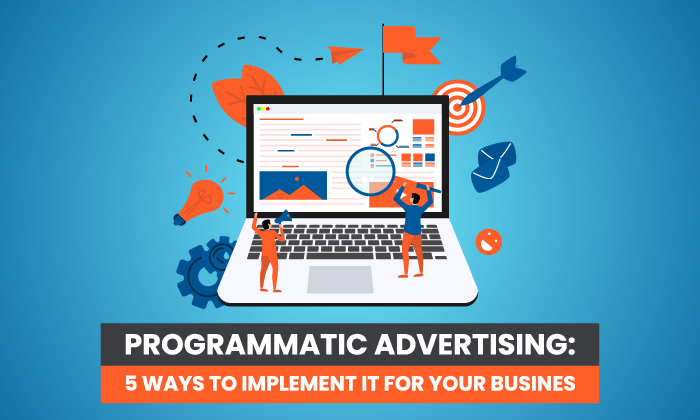
To be successful, paid ads need to be shown at the right time to the right audience. Not to mention, they need to be creative and relevant enough to capture attention.
Programmatic advertising is a game-changer for paid ads because it offers a solution to many of these issues. By automating the process of buying and selling ad space, programmatic ads can target consumers more precisely—for less cost.
In 2020, Statista reported global programmatic ad spending hit $129 billion, which means many brands are investing in this strategy.
Statista also reported programmatic advertising remains the leading method for buying and selling ads in the digital space.
If you haven’t jumped on the programmatic advertising bandwagon yet, now is the time.
Not sure if it’s right for your brand? Here are five ways programmatic advertising can benefit your business.
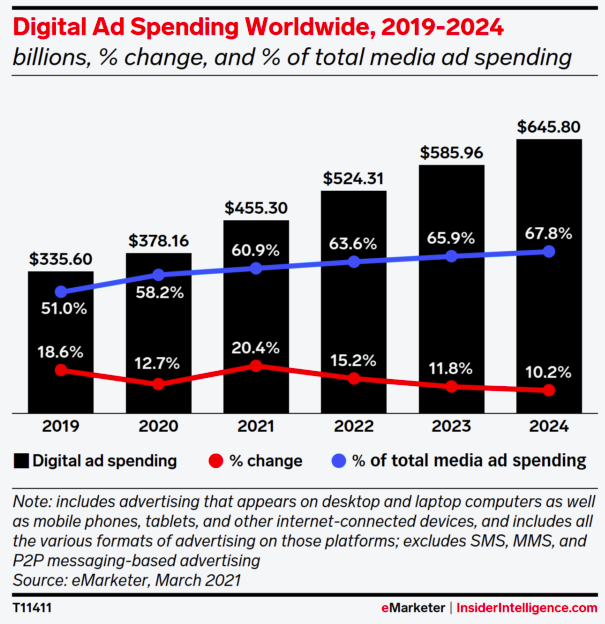
What Is Programmatic Advertising?
Programmatic advertising is a process that leverages automation in the ad buying process to help brands expand their reach and target users more efficiently.
Traditionally, media buying was a manual process where buyers research and identify placement opportunities, negotiate prices, make ad purchases, and track performance manually.
With programmatic advertising, all of these steps are automated using data insights and algorithms. This allows for ads to be served to the right user at the right time, and at the right price.
Programmatic advertising is made possible by programmatic ad platforms, or software that is used to buy and place ads.
Some of the most popular programmatic ad platforms include Google Ads, Microsoft Advertising, and Amazon Advertising.
How Does Programmatic Advertising Work?
Programmatic advertising works by using artificial intelligence (AI) technologies to analyze a visitor’s behavior to understand how likely they are to convert.
From there, programmatic companies gather this data and use it to target their ads more precisely and faster than humans.
For example, if you’re a travel company, you can target ads to people who have previously searched for travel-related keywords such as “vacation rentals” or “train tickets.” You know these customers are interested in travel, so your ads are more likely to be relevant and useful to them.
Similarly, a car company might target ads to people who have previously visited car-related websites. This can include car blogs, mechanic websites, or local dealerships.
Types of Programmatic Advertising
There are three main types of programmatic advertising. These are:
- Real-Time Bidding (RTB)
- Private Marketplace (PMP)
- Programmatic Direct
In programmatic RTB, media buyers place bids on advertising space in real-time, similar to how an auction works. The ad space is then sold to the highest bidder. This process happens in milliseconds, and all of it is automated using programmatic software.
According to Business Wire, the global RTB market is expected to grow at a compound annual growth rate (CAGR) of 22 percent between 2021-2026.
In programmatic PMPs, media buyers and sellers agree on a price for ad space ahead of time. This is done through programmatic direct deals or programmatic guaranteed deals.
Programmatic direct deals are one-to-one agreements between a buyer and seller, while programmatic guaranteed deals are one-to-many agreements (also called programmatic reserved deals).
Both RTB and PMP deals can be bought programmatically. However, programmatic direct deals are more expensive because they offer guaranteed ad space.
Here’s a quick breakdown from Publift.
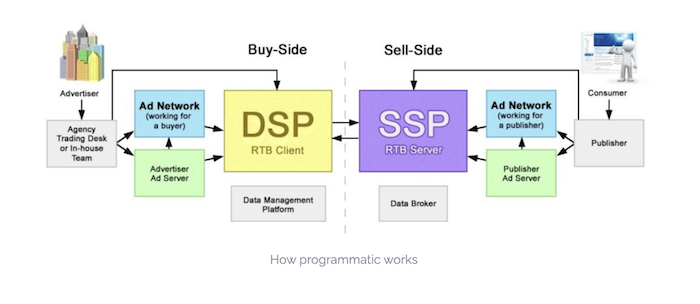
Benefits of Programmatic Advertising
Programmatic advertising makes up 72 percent of all digital display advertising spend. This means the time has never been better to get started with programmatic advertising for your business.
There are many benefits of programmatic advertising, including the ability to target specific audiences, increased transparency, and improved efficiency.
Programmatic advertising also offers a higher degree of control and flexibility than traditional methods.
Here are a few key benefits of programmatic advertising:
- Target specific audiences: One of the main benefits of programmatic advertising is the ability to target specific audiences. This can be done by targeting options such as age, gender, location, behavior, or interest.
- Increased transparency: Programmatic advertising offers increased transparency into the media buying process. This includes information on where your ads are being placed, how they are performing, and who is seeing them.
- Improved efficiency: Programmatic advertising can help improve the efficiency of your media buying by automating the process. This can save you time and money by reducing the need for manual optimization.
- Better ROI: Programmatic advertising can help you achieve a better return on investment (ROI) by allowing you to focus your budget on the most effective placements.
- Greater reach: Programmatic advertising gives you the ability to reach a large audience with your ad campaigns. This is due to the fact that programmatic advertising is not limited to one specific site or network.
When to Use Programmatic Advertising: Businesses and Products Best Suited for It
In the past, programmatic advertising campaigns were reserved for big-budget brands and agencies with the staff to manage them. However, with the rise of self-service programmatic tools, smaller brands now have access to this technology.
In fact, per Statista, a staggering 54 percent of U.S. media budgets are now dedicated to programmatic buying.
Businesses best suited to programmatic advertising include those looking to boost brand awareness, grow audience reach, or increase leads and conversions.
If any of these objectives are part of your advertising goals, programmatic should be a consideration.
Product categories that have seen the greatest success with programmatic advertising include:
- news and media
- consumer packaged goods
- fashion and apparel
- health and beauty
- computers and electronics
- home furnishings
- car manufacturers
5 Ways to Implement Programmatic Advertising
If you’re ready to take the programmatic plunge, it’s important to do it right the first time.
Understanding how to segment your audiences, target customer journey markers, and measure programmatic ad success is critical for programmatic advertising success.
Here are five ways to make sure your programmatic advertising campaign is set up for success.
1. Divide Your Audience Into Microsegments
Microsegmentation is the process of dividing your audience into very small groups based on shared characteristics. This can include factors like demographics, interests, or even previous customer behavior.
Here’s a breakdown of this from MobileMonkey.
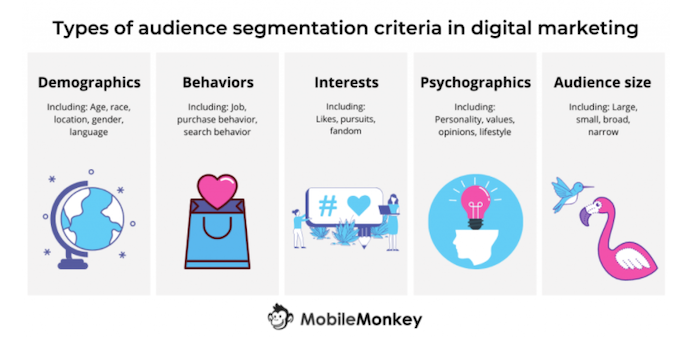
For example, if you’re selling a new type of running shoe, you might create a microsegment for people who have previously bought running shoes, people who have shown an interest in running shoes, and people who live in locations with good weather for running.
With microsegmentation, you’re targeting a very specific group of people with laser precision. This allows you to create ads that are highly relevant to them, which increases the likelihood of getting a conversion.
The downside of microsegmentation is it can be very time-consuming to set up. You need to have a clear understanding of who your target audience is and what characteristics they share. Once you’ve defined your segments, you need to create separate ads for each one.
Tools such as Google Ads Customer Match or Facebook lookalike audiences make it easy to target consumers who resemble your previous customers. Google Ads Audience Targeting also allows you to target individuals based on personal attributes.
2. Let Users “Design” Their Own Products and Serve Ads Based on Their Preferences
Another way to programmatically target ads is to let users design their own products and then serve them ads based on their preferences. This approach is often used by companies that sell custom-made products, such as shoes, jewelry, swag, and gifts.
For example, imagine you sell custom-made shoes. A customer comes to your website and chooses the style, color, and material of the shoes they want. They also select the size and width.
You can then programmatically target that customer with ads for the shoes they designed—and you can be sure those ads will be relevant to that customer.
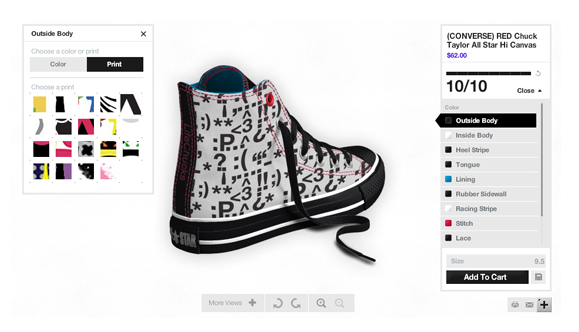
This approach is also useful for companies that have a lot of products and need to target their customers with the right product at the right time.
For example, a customer might be interested in buying a new car, but they might not be ready to buy it for several months.
You can programmatically target that customer with ads for the specific car they’re interested in and provide them with information about financing options and deals.
When done correctly, programmatic advertising can be an effective way to reach your target audience with the right message at the right time.
3. Run a Retargeting Campaign
One of the most effective ways to sell a product is to target people who have already shown an interest in it.
For example, if you know a customer has visited your site and looked at a particular product, you can programmatically target them with ads for that product.
This is called retargeting, and it’s an extremely effective way to increase sales.
Retargeting campaigns show your ads to people who have visited your website or taken a specific action, such as adding an item to their shopping cart or viewing a specific product page.
You can programmatically target these customers with ads for the product they’re interested in and offer them a discount or other incentive to buy it.
All you need is a pixel on your website that captures customer data, and then you can create a custom audience in your ad platform to programmatically target them.
One study found website visitors who see retargeting ads are 70 percent more likely to convert than those who aren’t, making it a simple way to increase conversions.
4. Run Ads According to Your Customer Journey
Understanding the customer journey is critical to programmatic advertising success.
To do this well, you need a clear understanding of your customers, what they’re trying to achieve, and the steps they take to get there.
Once you know this, you can map out the customer journey and identify key touchpoints where programmatic ads will be most effective.
For example, if you’re selling a new car, your customer’s journey might look something like this:
- I need a new car.
- I research what type of car I want.
- I compare different models and brands.
- I decide which car to buy.
- I buy the car.
As you can see, there are several touchpoints along the customer’s journey where programmatic ads could be effective, such as after they have researched what type of car they want or when they are comparing different models and brands.
Retargeted customers are three times more likely to notice and consider ads promoting products they’ve viewed before. If you can deliver savvy programmatic ads at these key moments, you’ll be well on your way to driving more sales for your business.
5. Use Video in Your Programmatic Ads
Using video in ads is a great way to stand out from the competition and capture attention.
Studies show more people are watching video content online than ever before, with video usage more than doubling since 2016.
This is likely because video is more engaging than other types of content, making it more effective at holding someone’s attention.
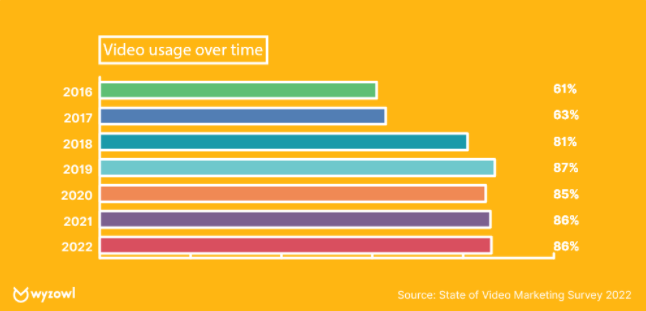
If you’re not already using video in your programmatic advertising, now is the time to start. Video ads are particularly well-suited to programmatic advertising because they can be dynamically inserted into ad space in real-time based on factors like the viewer’s location, demographics, and browsing history.
Ad space can be programmatically bought across platforms, such as through YouTube in-stream videos, or mid-roll videos on Facebook.
You can also purchase video banner ads programmatically, which can be placed on websites and apps your target audience is known to visit.
When you combine the power of video with programmatic advertising, you can create highly targeted and effective ads that also optimize your budget.
According to Statista, programmatic video ad spending is expected to increase to over $43 billion by the end of 2022.
Programmatic Advertising Frequently Asked Questions
How much does programmatic advertising cost?
Programmatic advertising costs can range from a few hundred dollars to tens of thousands of dollars per month, depending on your budget and goals.
What are the programmatic advertising ecosystems?
The programmatic advertising ecosystem includes real-time bidding (RTB), private marketplace (PMP), and programmatic direct.
Is Google Ads programmatic?
Google ads are programmatic in the sense that they are bought and sold through automated systems, but they are not RTB. When you use Google Ads, you only have access to the pages in their system. Programmatic advertising doesn’t limit itself to a single platform, meaning your ads will show up across the web in ad exchanges like AdForm, AppNexus, and Amazon.
Are Facebook ads programmatic?
Similar to Google Ads, Facebook ads are programmatic in that they’re bought and sold through automated systems. However, Facebook Ads Manager only distributes ads on its own platforms, meaning you’ll only have access to the people who are on Facebook, Instagram, Messenger, and Audience Network.
Conclusion: Programmatic Advertising
Programmatic advertising allows marketers to cut out middlemen from the media and ad-buying system, streamlining the process and making it more effective.
Additionally, because programmatic ads are bought and sold through automated systems, they’re able to target a specific audience with high levels of precision.
As programmatic ad buying continues to grow in popularity, it’s important for marketers to understand how programmatic advertising works and how they can use it to reach their target audiences.
The more programmatic advertising is understood, the more effective it will be for marketers looking to reach detailed audiences with their message.
How have you found success with programmatic advertising?
from Neil Patel's Digital Marketing Blog https://ift.tt/uWycbGU
via IFTTT
No comments:
Post a Comment